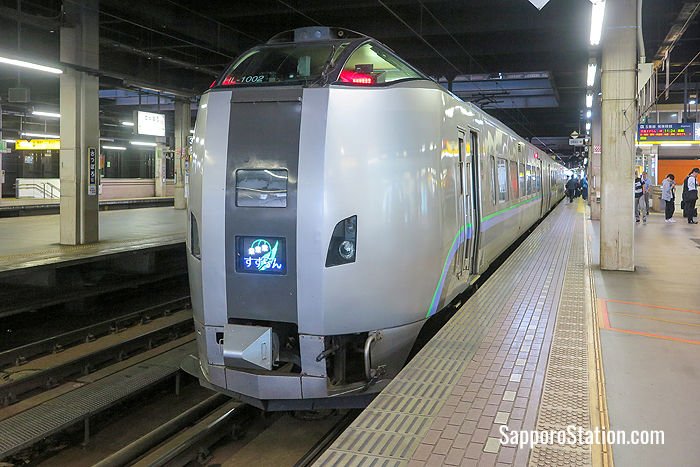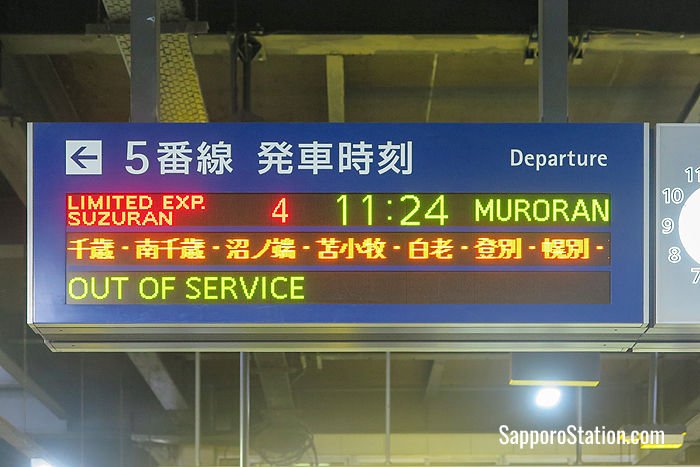The Suzuran is a limited express service operated by JR Hokkaido that runs between Sapporo and Muroran. The Suzuran is named after the Japanese name for the flower “lily of the valley”, and at the front of some trains this flower is depicted on the digital nameplate. Along the route of the Suzuran passengers can enjoy views of Mount Tarumae and the Pacific Ocean.

The Limited Express Suzuran at Sapporo Station
This train is fully covered by the Japan Rail Pass. At Sapporo Station this service may depart from Platforms 4, 5 or 6.
Key Destinations
There are 15 stops on the route of the Suzuran which travels via the Hakodate Main Line, Chitose Line, and Muroran Main Line.
Sapporo – Shin-Sapporo – Chitose – Minami-Chitose – Numanohata – Tomakomai – Shiraoi – Noboribetsu – Horobetsu – Washibetsu – Higashi-Muroran – Wanishi – Misaki – Bokoi – Muroran
Six southbound Suzuran services depart from Sapporo each day and six northbound services make the return trip.
- The southbound Suzuran #2 terminates at Higashi-Muroran Station.
- The northbound Suzuran #5 begins at Higashi-Muroran Station.
The key destinations are listed below with non-reserved fares and example journey times given from Sapporo Station.

Departure information at Sapporo Station
Sapporo Station
Sapporo is Hokkaido’s capital city and has great shopping, dining and entertainment facilities as well as plenty of museums and historic attractions. Famous sites are the 19th century Sapporo Clock Tower, and the wooden Hoheikan building in Nakajima Park. Sapporo Beer Museum and Garden is a popular location for beer and barbecue lovers, and for romantic travelers a trip to the summit of Mount Moiwa via cable car offers a sparkling view over the city. Sapporo is especially popular in February when the annual Snow Festival is held with ice sculptures and giant snow statues decorating the streets and parks of the city.
Transfers can be made here to local services on the Hakodate Main Line, Chitose Line and Gakuen-Toshi Line. This station also has limited express services for Hakodate, Abashiri, Wakkanai, Kushiro, Obihiro and Asahikawa, and rapid services for Niseko, Otaru and New Chitose Airport.
Shin-Sapporo Station
Sapporo Science Center with its family-friendly exhibits and planetarium is a 5 minute walk from this station. The Historical Village of Hokkaido is an open-air museum of historical buildings that demonstrates the life and conditions for people in early 20th century Hokkaido. The village is an 18 minute bus ride from the station. The Hokkaido Museum explores the history of Hokkaido through the relationship between nature, and human culture. The museum is a 15 minute bus ride from the station. For both the village and museum take bus 22 from bus stop 10 outside the station.
Transfer here to the Tozai Subway Line.
Train fare: 660 yen
Train time: 8 minutes
Chitose Station
Chitose is good base for visits to Lake Shikotsu, Marukoma Onsen and Shikotsu Onsen.
Lake Shikotsu is a large lake surrounded by volcanic mountains which is famous for its clear blue waters. Canoeing, kayaking, paddle boarding, fishing, camping, hiking and pleasure boat cruises are all popular activities on and around this lake.
There are two small hot spring resort areas by Lake Shikotsu: Marukoma Onsen is located on its northern shore and Shikotsu Onsen is located on the eastern shore. The Marukoma Onsen Ryokan offers luxurious accommodation and bathing facilities overlooking the lake and has its own boat for cruises on the waters. In Shikotsu Onsen, Kyukamura Shikotsuko is a traditional inn with hot spring bathing facilities and saunas, and also organizes activities such as nature treks, canoeing, and bird watching. Also in Shikotsu Onsen, Resort Spa Mizu-no-Uta is an upscale luxury hotel with a hot spring spa, two restaurants, a café and bar, a patisserie, and a hamburger stall. This hotel has a free shuttle service to and from Chitose Station and day trippers are also welcome to use the bathing facilities. Lake Shikotsu is a 40 minute bus ride from Chitose Station or 30 minutes by car.
Train fare: 1,600 yen
Train time: 25 minutes
Minami-Chitose Station
Northern Horse Park is a theme park which is 17 minute taxi drive from Minami-Chitose Station. The park has horse and pony shows, guided horse riding tours, carriage tours, and horse sled tours (in winter), as well as cycling, land car, balloon archery, laser shooting and other sporting activities.
Transfer here to the Sekisho Line and the Airport Branch Line of the Chitose Line.
Train fare: 1,600 yen
Train time: 29 minutes
Numanohata Station
Lake Utonai is a nationally designated wildlife conservation area and a paradise for bird watchers with over 250 species recorded in the area. There are a number of walking trails that you can take in the wildlife sanctuary area and there is also a Nature Center with an exhibition hall, an observation room with telescopes, and rangers on hand to give advice on what to see around the lake. The lake-side sanctuary can be reached from Numanohata Station in 12 minutes by car.
Train fare: 2,640 yen
Train time: 42 minutes
Tomakomai Station
Tomakomai is a good base for visits to two local sights of outstanding natural beauty.
Mount Tarumae is a 1,041m high active volcano and a designated Hokkaido Natural Monument. Because of the mountain’s gentle slopes, hiking to the summit is quite easy but rewards the hiker with wonderful views over the surrounding landscape. The hiking trail begins at the mountain’s 7th station which can be reached from Tomakomai Station in 20 minutes by taxi or rental car.
Lake Shikotsu is on the far side of Mount Tarumae and can also be accessed by rental car or taxi from Tomakomai.
Transfer at Tomakomai Station to the Hidaka Main Line.
Train fare: 2,830 yen
Train time: 49 minutes
Shiraoi Station
Upopoy: The National Ainu Museum and Park is due to open in Shiraoi in April 2020. The Ainu are the indigenous people of Hokkaido. At the new museum and park visitors will be able to experience various elements of Ainu traditional and contemporary culture and explore Ainu history, philosophy, language and lifestyle through exhibits, workshops, and performances. Located 10 minutes on foot from Shiraoi Station, this new National Museum will open on April 24th 2020.
Train fare: 3,250 yen
Train time: 1 hour and 5 minutes
Noboribetsu Station
This is the main station for the city of Noboribetsu which is mainly known for its volcanic hot springs, but which also has easy access to woodland hiking trails and a number of theme parks.
Noboribetsu Onsen is a famous hot spring resort which is 15 minutes by bus from Noboribetsu Station. There is a public bath where visitors can enjoy the natural mineral waters and many hotels here open their public baths to day trippers too. Jigokudani (or “Hell Valley”) is a dramatic landscape of steaming rocks and sulfurous vapors which is a 5-minute walk from the resort area.

Jigokudani (Hell Valley) in Noboribetsu
A short hiking route will take you to the boiling waters of Oyunuma Pond, and a stream that flows from this pond forms a natural footbath where weary travelers can soak their feet. Keen hikers will also enjoy the forested landscape around nearby Lake Kuttara. Two popular hotels in this area are Dai-ichi Takimotokan and Kashoutei Hanaya. These are ryokan: inns offering traditional hospitality, the best local cuisine, and luxurious bathing facilities.
Noboribetsu Marine Park Nixe is an aquarium and amusement park which is a 4 minute walk from Noboribetsu Station. The park features a replica Danish castle, an aqua tunnel for viewing marine animals up close, and amusements such as a Ferris wheel, merry-go-round, and gondola ride.
Noboribetsu Date Jidaimura is a replica village of the Edo era (1603 – 1868) where you can dress up in historical costume and watch dramatic ninja, samurai, and geisha shows. This theme park is a 10 minute bus ride or 5 minutes by taxi from Noboribetsu Station.
Noboribetsu also has a Bear Park which is accessed via a ropeway from Noboribetsu Onsen, and which includes a museum dedicated to Ainu culture.
Train fare: 4,250 yen
Train time: 1 hour and 19 minutes
Higashi-Muroran Station
From Higashi-Muroran Station the Suzuran follows a local branch line of the Muroran Main Line and stops at every station. Passengers who wish to continue on the main Muroran Main Line should transfer here to services bound for Oshamambe Station.
Train fare: 4,690 yen
Train time: 1 hour and 35 minutes
Wanishi Station
Itanki Beach is a popular scenic spot which is a 4 minute taxi ride (or 25 minutes on foot) from this station. The beach is famous for its naki-suna or “singing sands” which make an unusual squeaking noise when walked on.
Train fare: 4,690 yen
Train time: 1 hour and 39 minutes
Bokoi Station
This station is a 7 minute taxi ride (or 30 minute walk) from the Tokkarisho Lookout Point which is a popular beauty spot with gorgeous views over the Pacific coastline.
Train fare: 4,690 yen
Train time: 1 hour and 44 minutes
Muroran Station
Muroran is an industrial port city on Uchiura Bay with access to a number of scenic attractions. The rugged coastline near Muroran is noted for its breathtaking natural scenery. Cape Chikyu is a particularly well known coastal observation point with a lighthouse that is 10 minutes from Muroran Station by taxi, and 15 minutes by bus. The Hakucho Suspension Bridge is the city’s most famous landmark and the illuminated night view of both the city and the bridge is very beautiful.

Muroran cityscape with the Hakucho Suspension Bridge in the background
Within the city the observation deck on the summit of Mount Sokuryo is a popular hiking destination and a good spot for both daytime and nighttime views of the city. Boating excursions are popular with tourists, and the Starmarine company runs a variety of sightseeing cruises from Muroran harbor. These include a nighttime pleasure boat cruise around Muroran port, daytime cruises to Cape Chikyu, and from June through August there are also dolphin and whale watching cruises in the waters around Muroran. To find your way around the city and to find out more about local cruise activities, head first to Muroran Sightseeing Information Center which is just an 8 minute walk from Muroran Station.
Train fare: 4,690 yen
Train time: 1 hour and 47 minutes

A carriage banner on the Suzuran
About the Suzuran
The Suzuran is a 5-car train set that uses either the #785 series or #789-1000 series trains. Four cars have non-reserved seating and Car 4 has reserved seating with “u seats”. These “u seats” are more spacious than regular seats and have their own power outlets. The Suzuran does not have a Green Car with 1st class seats. This train also has a wheelchair accessible toilet and a storage space for extra-large baggage.
Useful Information
A timetable and route finder, and a downloadable route map can be found on the official JR Hokkaido English language website.
Article by Michael Lambe. Photos by Michael Lambe, Angkana Unthaya (3), keiji kawamura/pixta (4). All rights reserved.
